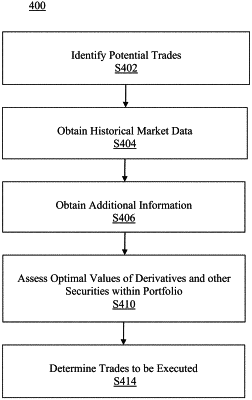| CPC G06Q 40/06 (2013.01) [G06Q 30/0201 (2013.01); G06Q 40/04 (2013.01)] | 22 Claims |

|
1. A method for accessing data stored in a data repository and a management database and using the accessed data to perform identifying, obtaining, assessing, and determining operations, the method comprising:
performing communications over a communication network between a historical market data repository and a network interface of a derivatives and securities portfolio management module of a Data-Driven Derivatives Risk and Inventory Engine device having at least one processor;
performing communications over the communication network between a portfolio management database and the network interface of the derivatives and securities portfolio management module of the Data-Driven Derivatives Risk and Inventory Engine device;
accessing historical market data including price data for individual securities and market indexes stored in the historical market data repository with the derivatives and securities portfolio management module of the Data-Driven Derivatives Risk and Inventory Engine device;
accessing portfolio management data that includes data relating to securities, bonds, derivatives, and hedging instruments that are included in a portfolio stored in the portfolio management database with the derivatives and securities portfolio management module of the Data-Driven Derivatives Risk and Inventory Engine device;
identifying, by the derivatives and securities portfolio management module of the Data-Driven Derivatives Risk and Inventory Engine device, a plurality of potential trades based on the portfolio of securities and derivatives stored in the portfolio management database;
obtaining, by the derivatives and securities portfolio management module of the Data-Driven Derivatives Risk and Inventory Engine device, historical market data that relates to the identified plurality of potential trades stored in the historical market data repository;
assessing, by the derivatives and securities portfolio management module of the Data-Driven Derivatives Risk and Inventory Engine device, a respective optimal value of each of at least one security that relates to a corresponding one of the potential trades for a current portfolio;
determining, by the derivatives and securities portfolio management module of the Data-Driven Derivatives Risk and Inventory Engine device, at least one potential trade from among the identified plurality of potential trades based on the corresponding optimal values,
wherein the assessing the respective optimal value is performed based on the obtained historical market data stored in the historical market data repository, and
wherein the assessing comprises using a machine learning technique to model a joint distribution of profit-and-loss values of the portfolio of securities and derivatives stored in the portfolio management database, and wherein the using of the machine learning technique comprises building a training data set that includes historical profit-and-loss values of delta hedged options for each of a plurality of times from within a predetermined time interval and corresponding aggregate explanatory variables that relate to information known at each of the plurality of times; and
building the training data set by
computing the historical profit-and-loss values of delta hedged options within the predetermined time interval,
stacking the aggregate explanatory variables over the predetermined time interval,
selecting the delta hedged options whose profit-and-loss values are used in the training data set to have the same delta and the same relative maturities as the options in the current portfolio and a current hedging set; and
wherein the assessing of the respective optimal value includes assessing a risk-adjusted value of the optimal value by
computing the historical profit-and-loss values of delta hedged options within a plurality of predetermined time intervals, and
assigning different probabilities to the historical profit-and-loss values in the plurality of predetermined time intervals, each assigned probability for one of the predetermined time intervals being based on the distance between a current market environment and the market environment prevailing at the one predetermined time interval by using an implied volatility surface to characterize the current market environment and the market environment prevailing at the one of the predetermined time intervals.
|